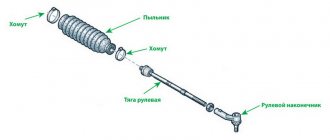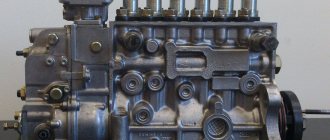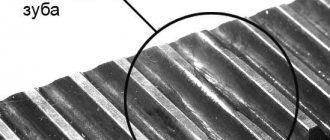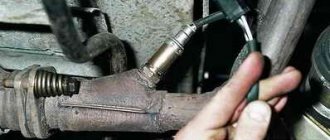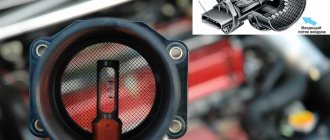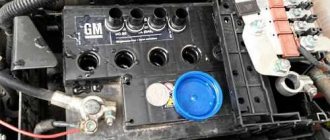Steering rack device
Car steering racks, regardless of modification, consist of the following parts and mechanisms:
- Tips and rods. They are a continuation of the retractable rack mechanisms, with the help of which force is transmitted to the wheels and they are rotated.
- Toothed bar and gears. With their help, force is transmitted from the steering wheel to the rods to control the wheels.
- Carter (body). In most cases, it is made of aluminum alloy, inside of which the main parts of the rack are located.
- Spring system. They serve to tightly fit the gears to the rack; if they are in good condition, there will be no play in the steering wheel.
- Bearings. Serve to ensure ease of movement and rotation of the steering rack.
- Limiters. Set the limit for the maximum travel of the rack from one edge to the second.
Causes of malfunctions
The steering rack is a fairly reliable component of the car, but under special operating conditions it wears out faster, and as a result it fails.
The main causes of rack malfunctions are as follows:
- Regular operation of the vehicle on uneven roads, careless driving, getting a wheel into a hole at high speed.
- Sharp acceleration when the steering wheel is turned to the extreme left or right.
- Regular collisions with curbs and obstacles.
Symptoms of a problem
There are typical signs that can be used to diagnose a faulty car steering rack. If it is paired with power steering, it is important to distinguish between its breakdown and the rack mechanism. The main faults of the rack correspond to a specific symptom from the following list:
- Knocking in the rack is characterized by two types:
- Superficial - is a consequence of a rupture of the traction boot, and as a result of dirt getting inside, the tip quickly wears out, a backlash is formed, and knocking begins;
- Internal - indicates a more serious malfunction inside the rack mechanism, the cause of which is difficult to determine without disassembling the unit.
- Backlash in the rack. It can be caused by play in the steering rod joints, the central tooth of the shaft on the rack or the crayon, wear of the silent blocks attached to the body, mechanical damage and other reasons.
- Vibration of the steering wheel when driving straight and on a not too smooth road, which weakens or disappears when turning the steering wheel in any direction.
- The steering wheel does not return to its original position or rotates poorly if the shaft or rack housing is bent.
- The steering wheel rotates tightly and a characteristic whistle is heard. This can happen when the drive belt is loose, the rotor pair is heavily worn, or the power steering fluid level is below the minimum level.
- Steering rack leaking. It appears when rubber seals fail. This is a typical breakdown of a steering system equipped with power steering, in which the fluid in the power steering system is lost daily, and to replenish its level it is necessary to frequently top up.
- The hum of the rack (mechanism) occurs when the circulation of fluid in the power steering system is disrupted, and the steering wheel is difficult to turn. Such signs indicate a failure of the pump, which is not able to create the required pressure.
Signs of breakdown
Tie rods have two main enemies.
- Dirt. PH are hinged parts, therefore, when the boot is damaged, various solid particles of debris, dust, and dirt begin to enter the mechanism. Friction occurs, parts begin to wear out faster, and moving components are destroyed.
- Bad roads. How many bumps, holes, curbs do you have to overcome every day? All these impacts negatively affect the condition of the tips - the hinge begins to actively wear out, and play occurs in the vertical direction.
If a tip is found to be faulty, it must be replaced. It is better not to do with restoration and restoration of functionality.
Many people are interested in the question of how you can check the steering tips and make sure they are worn out or, on the contrary, intact. It is not necessary to go to a service station and pay money for this.
To check the condition of the LV, you need to turn the wheel all the way in one direction and remove all dirt from the boot. If there are breaks or cracks in the rubber, then the part has worn out and no longer performs its functions properly. Do subject to replacement. The second wheel is checked in a similar way.
There is one more important measure that is recommended to be carried out even if there are no signs of wear on the launch vehicle. To do this, a pry bar is inserted between the steering knuckle and the rod, after which the parts are moved relative to each other. If no vertical play occurs during these manipulations, everything is fine. If it is, you will definitely have to change the component.
Basic steering rack faults
It is quite difficult to list all possible malfunctions of the steering rack mechanism, taking into account the design features of various models. To classify problems, a simplified list is used, from which the location of the problem is determined, and measures are taken to eliminate it:
- A breakage inside the rack is a problem with the gear or gear mechanism.
- Deformation of the rack body completely immobilizes the car.
- There is a violation of the tightness, due to which dirt and dust gets inside the case, completely disabling the rack.
- Critical wear of the mechanism inside the rack, after which driving the car becomes impossible.
- Violation of the integrity of tips, rods due to bending, cracks, force (damage, impact) or corrosion.
Main malfunctions and their symptoms
If the following symptoms occur, you should diagnose the steering rack:
- The steering wheel gets jammed while the car is moving, causing difficulties in steering – the steering shaft is damaged or displaced; among auto mechanics this phenomenon is called “biting”.
- A knocking sound appears in the chassis - this requires repair of the rack elements.
- The car pulling to the side, the car wobbling at high speed are signs of play in the steering mechanism. Because of this defect, it is impossible to perform a wheel alignment.
Depending on the degree of damage, the problem can be solved by repair (installation of a factory repair kit), replacement of the entire assembly, or adjustment. This material contains instructions for adjustment and repair.
The main causes of steering rack malfunctions
Every motorist must know the causes and signs of a steering rack malfunction, because problems with controllability can lead to an emergency situation on the road.
If the steering rack mechanism begins to fail, there are reasons for this - driving on bad roads or an aggressive driving style. When car wheels fall into holes or run over curbs, this causes additional loads on the mechanisms and, as a result, wear on the steering rack. Another important cause of breakdowns is dust; its small particles quickly clog the mechanism.
The main causes of steering rack problems are the driver’s rash actions, these are:
- Driving at high speed through potholes and speed bumps;
- Crossing rails and other obstacles without reducing speed;
- Turned wheels during long parking;
- Vigorous steering movements when the car has not yet warmed up.
There are many factors that cause steering failure. To avoid costly repairs, you must promptly seek help from an auto center that has specialized equipment for diagnosing the steering rack. Remember that repairing the steering rack will be less expensive at the initial stage of the breakdown.
What are the signs that indicate a faulty steering wheel?
The main one is the beating and noticeable vibration of the steering wheel. This is due to the fact that the element has completely exhausted its resource, is in a faulty condition, and needs to be replaced. However, this symptom may also indicate the presence of other problems with the steering or chassis of the car. If you have any suspicions about the serviceability of a part, you need to perform simple testing, which will help confirm or refute them.
Signs of faulty tie rod ends are quite easy to recognize. For example, when moving, a characteristic sound begins to appear, more like a knock. It often intensifies when entering a turn, accelerating, sharp braking, or driving on a road with an unsatisfactory surface condition. If the knocking continues to be present, and its magnitude increases each time, it is necessary to immediately diagnose the car’s steering system, in particular, check the tips in order to assess the degree of wear of their hinge joints.
In conclusion, we can say the following: since the part is a consumable element of the vehicle, in order to maintain its control system in good condition and ensure correct operation, you should not wait for the scheduled replacement period. The tie rod end will fail, which will create certain problems.
Signs of steering rack failure
To fix a problem with the steering rack, accurate diagnostics will be required. A steering rack test stand will help you quickly and accurately diagnose a breakdown, but to do this you need to visit a car service center.
If the driver knows the main faults of the steering rack, it will be possible to avoid replacing the steering rack. Signs of mechanism destruction:
- A knocking sound in the steering rack (play);
- Oil leakage;
- Difficulty turning wheels;
- Difficulty with control (hard steering).
To test the steering rack, you need the help of specialists and diagnostic equipment from MSG Equipment. It is impossible to replace the steering rack if there is some damage, then the rack is replaced with a new one. Diagnostics of the power steering pump is carried out at the MSG Equipment stand if there is a suspicion of a faulty power steering. Remember that even minor problems with power steering can cause an accident, so do not try to check the operation of the mechanism yourself.
Steering ends: signs of malfunction
New set of tips for VAZ racks
Steering ends are replaced when the following symptoms are observed: when driving over uneven surfaces, when accelerating or braking, a knock is felt, the steering wheel begins to vibrate and shake, play is noticed in the steering rod, and kickback is observed in the gas pedal. You can fully check the serviceability of the tips by checking the integrity of the anthers, etc.
Since these parts affect wheel alignment, they must be replaced on time so that the rubber does not start to wear unevenly.
The steering tips are changed on both sides at once (if one breaks, then after a while the other will break too).
When performing repair work to replace VAZ 2114 tips, the following tools are used:
- The key is “19”, the key is “24”, the key is “27”.
- Calipers.
- Press-out puller or mounting tool.
- Hammer.
- Brake fluid or chemical WD-40.
All work related to replacing tips on a VAZ 2114 can be performed either on a lift, or, as in this case, using a jack.
What to do if the steering rack is broken
Service station specialists will conduct an external inspection of the rack for corrosion and mechanical defects. MSG Equipment diagnostic equipment will help the technician complete his work as quickly and efficiently as possible.
When you arrive at a car service center, pay attention to the professionalism of the staff and the availability of specialized equipment. To get your car back to work in a short time, you will need equipment for diagnosing and repairing the steering rack from MSG Equipment. Every car service center that specializes in diagnosing and repairing steering mechanisms has such equipment.
Signs of a faulty steering rack
What are the signs of a faulty steering rack - all the details in our article!
A properly functioning steering mechanism is the basis for traffic safety. Every driver should know the signs of a faulty steering rack and pay attention to them in a timely manner.
First, let's look at the basic definition. The rack is the main element of the steering system, the task of which is to convert steering rotation into deflection of the front wheels.
We recommend reading these articles:
Steering rack for VAZ 2114: replacement, tools
An experienced technician can identify a malfunction in a car by sound. If you hear a knocking noise coming from under the front axle that gets worse over time, then it’s time to check the steering rack. However, when the damage is serious, noticeable vibration is transmitted to the steering wheel. If you ignore this problem, the mechanism will become loose and make driving impossible. The defect only appears on uneven road surfaces, so it will be quite easy to identify. This article describes in detail how to replace the steering rack of a VAZ 2114, signs of a malfunction of this unit, as well as the causes of failure.
By opening the car's service manual, you can find a diagram of the steering device. From the steering wheel comes a shaft that goes into the steering rack. Dismantling work takes place in the interior and engine compartment. The rack structure includes the following main elements:
- Cardan joint.
- Steering shaft.
- Protective boot.
- Rail body.
- Steering gear housing.
Repair or replacement?
A knock in the steering wheel is just one of the signs of a broken unit. Also, if the rack is faulty, smudges appear on the steering shaft, and stains of working fluid remain in places where the car is parked for long periods of time. Having accurately determined that the problem is in this part, motorists are faced with the question of whether to buy a completely new mechanism or try to repair it on their own. The second option should be chosen only if there is not enough finance to purchase a new unit.
Types and design of steering racks
A mechanical steering rack can be considered the simplest version of the mechanism. In racks of this type, the rotation of the wheels is carried out by applying the physical force of the driver. To facilitate the process, a variable tooth pitch (varies from the central part to the edges) or a variable gear ratio is used. This design ensures relatively easy rotation of the steering wheel during maneuvering at low speeds and at large steering angles. At small angles of deflection, the “steering wheel”, on the contrary, is filled with heaviness, and the machine’s reactions are “sharp”.
A more complex type is considered to be a hydraulic rack or, more simply put, a rack with a hydraulic booster, which makes the driver’s work easier. Devices of this type are very common, although racks with electrical amplifiers are now actively used. The advantage of hydraulic steering racks lies not only in obvious comfort (with them it is disproportionately easier to rotate the steering wheel than with purely mechanical structures), but also in the aspect of safety - if the car falls into a hole, the steering wheel does not tear out of your hands, since the power steering absorbs the impact. It is worth noting that an excessively powerful hydraulic booster worsens the contact between the driver and the car - due to the excessively reduced force on the steering wheel, it is sometimes difficult to accurately feel the angle of rotation of the wheels, the trajectory in corners is literally groped, and there is no desired feedback from the car. It should be noted that power steering does not like prolonged fixation of the steering wheel in extreme positions and at the same time a sharp increase in engine speed, at which the pressure increases. Simply put, drifting is not encouraged.
Electric power steering rack diagram
On some models, electric steering racks are criticized due to the fact that they do not provide feedback and “clean” communication with the car, but, nevertheless, its advantages cannot be ignored. The electric power steering does not depend on the ambient temperature and does not require specific maintenance, which is necessary in the case of power steering (monitoring the level of working fluid and replacing it). Finally, the electric booster is economical (the motor is activated only when the steering wheel is turned) and has a higher efficiency compared to the hydraulic booster.
Steering rack repair on VAZ-2113, 2114, 2115
It is important for every driver that the car obeys him well in any situation. One of the main systems of a car is the steering system.
Therefore, every breakdown of the steering system leads to a deterioration in driving quality, and possibly even to an accident.
It is for this reason that it is important to always monitor the condition of the steering system and promptly carry out its repair and maintenance. Today we will talk about the VAZ 2114, or more precisely about its steering rack.
The steering rack itself is a long rod with attachments and two outgoing parts. The steering rack is responsible for the handling of the car and also for the safety of the driver, so if it breaks down, you should immediately begin repairs.
You can understand that the rack requires replacement by the following signs: when you turn the steering wheel, you hear a knock and play appears. In this case, the knocking sound most often appears only when driving; if it is heard when turning the steering wheel while parked, then the steering rack definitely requires immediate replacement - this means that the breakdown has started and the rack is in critical condition.
Malfunctions
Often the rack does not require complete replacement. The fact is that when knocks and backlashes appear, it is often possible to make a fairly quick repair; all that is required is the presence of an inspection hole. To do the repair yourself, you need to purchase a repair kit for the steering rack, which is sold in three versions - from basic to advanced.
The very first step will be to tighten the steering rack. It is enough just to tighten the adjusting bolt using a 17mm wrench.
After this, it’s worth taking a test drive and checking whether there is any play or knocking left. If there is no more play or knocking, then you can finish working on the steering rack for now. If nothing has disappeared (or, for example, the play has disappeared, but the knock remains), then more extensive work will be required.
Causes of steering rack malfunctions
As mentioned above, the driver should be very careful about the condition of the steering mechanism and not ignore the symptoms of malfunctions, in particular, changes in the behavior of the car, leaks and extraneous sounds.
First of all, these are knocking noises that appear on a bad road and decrease when turning the steering wheel from lock to lock. In such situations they say that the steering rack is knocking. It is worth going to a service if the steering wheel stops returning to the “zero” position after a turn, or the car suddenly becomes nervous and reacts very sensitively to its most minor deviations. And, of course, you shouldn’t delay repairs when the power steering reservoir is regularly empty, the mechanism makes howling sounds, and it’s very difficult to turn the steering wheel.
VAZ 2114, is it possible to install an amplifier yourself?
The work will take no more than two hours if you do everything without haste and with breaks. There is no need to remove the VAZ steering rack; there is no need to even disconnect the rods. You will need a small set of keys: for 10, 13 and 17. The last two are needed. It is advisable to have a good set of tools, since pliers, for example, may be needed at any time.
First you need to remove the left clamp and install the amplifier clamp located on the left on the studs. Moreover, its eye should be facing upward. After this, tighten all the nuts. The clamp on the right side of the steering rack is replaced in the same way. Then you need to put the corner of the rack on a pin located on the cross beam of the car body.
If there is an adsorber tube, remove it first and then install it on top of the corner. The entire structure must be tightened by placing a large washer on the stud. Next, the cross member is installed; its two bolts must be tightened simultaneously.
If there is a gap of about 1 cm in the structure, you will need to rearrange the clamps. Most likely, you mixed them up and installed them incorrectly. This completes the installation, now you can check the VAZ power steering rack in action.
The difference will be immediately felt, the car's handling will become much better, and it will be easier for you to stay on course. If necessary, adjust the rack to minimize the backlash. >Video: How to tighten the steering rack of a VAZ 2114
What is the steering rack afraid of?
Corrosion (or, more simply, rust) is one of the main enemies of the slats and this is a very important point. Experts note that in some cases it is provoked by servicemen who, when replacing steering rods, tighten their boots with plastic clamps, or with standard metal elements. Of course, with this approach there is less fuss, but plastic clamps do not ensure 100% tightness of the anthers. The following picture emerges: one boot draws in warm air from the engine compartment, and the other squeezes it back out. It would seem, what's special here? But don’t forget about the condensation that forms as the air cools. This is how the slats rust.
We recommend reading these articles:
How to service the hydraulic booster
Should I change the fluid in the power steering reservoir or not? Most automakers say nothing about the timing, hinting that it is filled for virtually its entire service life, but many services change it once or twice. Some experts, however, recall that darkening of the liquid does not mean a loss of working properties and believe that replacement can be harmful. The fact is that air enters the system, which can provoke turbulent flows, causing oil starvation of the pump and washing away dirt from the walls of the lines into the rail.
When replacing, be sure to take into account its base - it can be mineral or synthetic. Pouring “synthetics” into a system intended for “mineral water” will render the rubber components unusable.
We advise you to read:
- How to deal with steering wheel wobble in a car?
- New inspection rules 2018
- How to protect your suspension on a bad road: useful techniques


